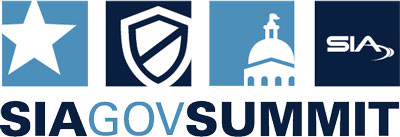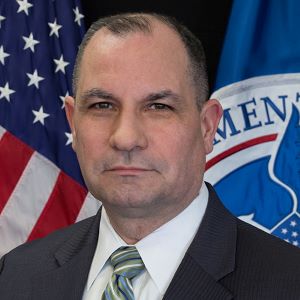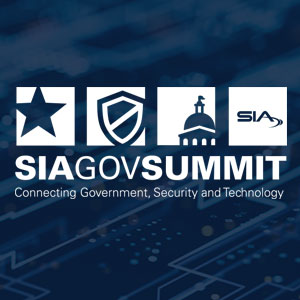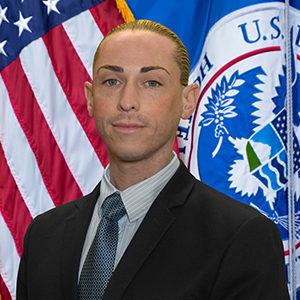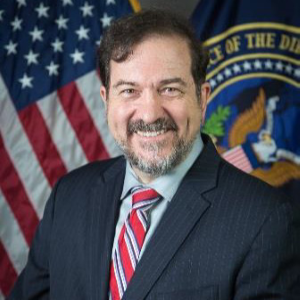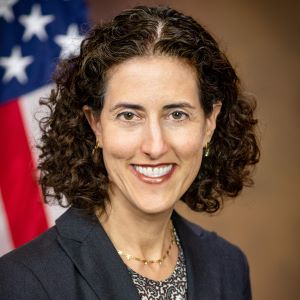SIA GovSummit Agenda
Where:Atrium
Check in for GovSummit at our registration desk, enjoy breakfast and networking with other event attendees and stop by our exhibitor tables.
Where:Auditorium
Where:Auditorium
Where:Auditorium
SIA will present the 2024 SIA Women in Biometrics Awards.
Where:Auditorium
In this panel discussion, participants from large enterprises and multinational technology companies deep in the government vertical market will share their experiences and insights on the digital transformation of physical access control. We will explore how the industry has evolved into an enterprise software industry, the challenges and opportunities this change presents and how to keep up with fast-paced technology changes and a dynamic landscape. This session will provide greater insights on 1) the impacts of digital transformation on the physical access control industry and it influences the way the industry functions, builds, sells, implements and operates, 2) best practices for implementing high assurance credentials in onsite, cloud and hybrid architectures and 3) lessons learned when high assurance and a high level of convenience are needed.
Where:Atrium
Enjoy coffee, network with other GovSummit attendees and stop by our exhibitor tables during this break.
Where:Auditorium
What do high security and access control in the government sector really mean? There are stringent requirements for the types of credentials allowed to be used by federal employees in highly sensitive positions. Traditionally, these employees have relied on various types of PIV cards; however, many federal employees don’t fall into this classification – such as office staff, janitorial staff, patients in VA hospitals or faculty, staff and students at schools run by the federal government. These individuals have historically been provisioned run-of-the-mill plastic cards that can be insecure and difficult to manage.
These higher-risk proximity cards can be transitioned to Bluetooth-based mobile credentials to make accessing federal buildings easier and more secure, and Bluetooth Low Energy technology can be used for secure reader configuration; however, there is significant hesitance to use a Bluetooth technology in the government sector, despite the potential benefit of newer solutions such as mobile credentials.
Additionally, there are a host of physical access control solutions on the market. SIA Open Supervised Device Protocol-supported access control systems can communicate and exchange data securely and efficiently, ensuring only authorized individuals can access certain areas – and therefore preventing unauthorized physical access and potential security breaches; however, not all systems are created the same. Cards can now also contain embedded authorization, which allows users to digitally verify against a federal repository for that credential holder.
This panel will explore these newer access control technologies, cover best practices in access control for the government sector while maintaining federal standards and address the questions audiences need to be asking to inform their government security decisions and select the right solution for them. The session will also work to overcome the myth that “Bluetooth is bad” and educate attendees on what is allowed in the government sector in terms of Bluetooth and mobile credentials. Attendees will have the opportunity to ask questions during a Q&A portion following the panel.
Where:Conference Room
U.S. Customs and Border Protection (CBP) stands at the crossroads of national security, safeguarding our borders while facilitating legitimate trade and travel. Within this essential mission, Operations Support (OS) plays a pivotal role, going beyond simply equipping law enforcement with cutting-edge technology. OS also develops CBP policies/procedures and provides requisite training to ensure officers/agents are prepared and equipped to meet the mission. This session focuses on the intersection of emerging tech and effective governance to empower law enforcement.
Where:Auditorium
Managing risk during an involuntary separation of an employee is essential. Whether the employee is a contractor or directly employed by a government agency, the challenge and risk to the organization is great. This session will detail a real-world case study that identifies the gaps and solutions associated with involuntary employee separations, and present a risk-based protocol for managing risk effectively. This includes a protocol for conducting an employee separation risk assessment, keys to success for managing access to facilities and IT systems and post-separation vigilance. As each separation is unique, security practitioners need to be proactive in developing a process and plan to assess risk and implement mitigations to reduce undesirable events.
Where:Conference Room
Many agencies have provided guidelines and directives regarding hostile vehicle mitigation. We are now seeing a trend where these guidelines are being expanded to include the identification, verification and authorization of individuals as they enter a restricted area or access-controlled area within a vehicle. This is a unique challenge due to the different make, models and size of vehicles as well as the number of passengers in a vehicle as they approach a given controlled or restricted area. In this session, we will discuss the challenges associated with these types of deployments. We will also review examples of technologies that have been developed to meet the challenging conditions of capturing valid facial recognition through a moving vehicle at varying speeds with multiple occupants. In addition, conversations will include lessons gained from these types of deployments while ultimately providing agencies with advance notification of individuals that may be associated with a watchlist to enable proactive responses in real time while increasing the safety for both the public and employees.
Where:Atrium
Enjoy lunch, network with other GovSummit attendees and stop by our exhibitor tables during this break.
Where:Conference Room
Defrauding government benefits programs has become a humanitarian issue whereby well-intended funds are consistently lost to bad actors – and the scale is staggering. Without a more risk-based approach, the levels of criminal activity focused on defrauding public assistance programs will only increase. Criminals are now equipped with the technology and tools to plunder public sector benefits at scale systematically. In addition, the Federal Reserve and other agencies have been very public in stating that identity fraud is often used to fund other criminal activity and even state-sponsored terrorism.
This session covers:
- The challenge of ensuring that someone is who they claim to be remotely
- The fast pace of generative AI-based technologies and how they threaten remote identity verification systems
- How many traditional security methods cannot counter the scale and complexity of modern fraud have become easy to circumvent by cybercriminals
- How face verification is the most robust method of authenticating a user identity online
- The importance of delivering a solution that transcends biases and provides an inclusive and equitable authentication experience for users of all skin tones and ages
Where:Auditorium
The time to modernize and bring together previously siloed security systems and create a paradigm shift for how government facilities and agencies approach security is now. The advancement of technologies and OT/IoT devices are increasingly bringing all facets of an operation or business into an interconnected cyber-physical ecosystem that can make traditional physical security and safety systems more vulnerable. Discussions will explore creating an infrastructure that supports a common operating environment to refocus emphasis from single-problem sets to holistic, connected views for better situational awareness and actionable intelligence.
Where:Auditorium
Panelists from the U.S. Department of Homeland Security (DHS) Science and Technology Directorate (S&T) Office of Industry Partnerships will discuss how industry partners can work with S&T through its unique innovation-funding programs and current opportunities to adapt, develop and commercialize technologies in support of DHS missions.
S&T relies on private-sector partners to help discover scientific advancements and technological innovations that solve homeland security challenges. From entrepreneurs and academia to small businesses and large corporations, S&T has unique tools for private-sector entities to help them find new and emerging technology that can be designed, adapted and used for homeland security. Key takeaways for attendees will include an understanding of the ways in which innovators can work with government, specifically S&T, the available funding opportunities in which innovators can submit to work with the government through specific programs and how participants can connect with S&T given their organization type and interests.
Where:Conference Room
The U.S. government has imposed prohibitions on agency procurement and grant purchase of certain Chinese video surveillance and other communications equipment, over national security concerns, has imposed various sanctions on certain manufacturers and has longstanding procurement policies under the Trade Agreements Act (TAA) that prevent purchase of Chinese equipment under many circumstances. Agencies continue to grapple with issues stemming from implementation and compliance with these policies. For example, in January 2024, an inspector general’s report noted that the General Services Administration used “egregiously flawed” market research in its decision to purchase 150 non-TAA compliance Chinese-made video conferencing cameras. Numerous recent polices direct agencies to protect against counterfeits, tampering, theft, insertion of malicious software, poor manufacturing and development practices, etc., throughout a systems development life cycle. This session will present these and share lessons learned in finding and addressing prohibited or counterfeit equipment and malware, involving chips, boards and devices.
Where:Atrium
Network with other GovSummit attendees and stop by our exhibitor tables during this break.
Where:Auditorium
Led by SIA Procurement Policy Working Group Chair Lynn de Séve, this session will feature important policy updates, technical considerations and other requirements and enhancements to the GSA Contract program for security products in 2024, of interest to both government contractors and government agency customers.
Where:Conference Room
Open-source software (OSS) is code which is freely available for use and is very commonly used for development of both software for information technology plus firmware for operational technology. Current estimates place 98% of codebases containing OSS with OSS constituting 76% of code in use. OSS is a matter of ease of use, but comes with cybersecurity implications since the source code is equally open source which makes it opportune to exploit.
The U.S. Department of Homeland Security’s Science and Technology Directorate and Cybersecurity and Infrastructure Security Agency have an effort where they seek to empower organizations with greater visibility into the OSS amongst their networks/infrastructure to better risk-inform future network/infrastructure assurance.
Where:Auditorium
For the last 40 years, globalization and worldwide supply chains have been a major priority across industries and have dominated economic trends; however, a drive for greater domestic industrial bases coupled with post-COVID-19 pandemic effects causing supply change challenges is quickly changing that economic model. The speed with which supply chains are being reoriented, both domestically and internationally, is profound and it is important to stay on top of the changes.
Within the U.S., we are increasingly seeing both political parties support efforts meant to bolster “reshoring,” “onshoring,” “deglobalization” or “Buy America.” For businesses seeking to partner with federal, state and local governments ensuring “Buy America” compliance is becoming necessary, though sometimes complicated and arduous task. This session will examine the impacts new Buy America provisions are having on government procurement, how compliance issues are being addressed, the best way to navigate these requirements and how Buy America will change supply chains in the coming years.
Where:Atrium
Wrap up Day 1 of GovSummit with networking, drinks and hors d’oeuvres, as well as visiting with our exhibitor tables, during this lively cocktail reception.
Where:Atrium
Check in for GovSummit at our registration desk, enjoy breakfast and networking with other event attendees and stop by our exhibitor tables.
Where:Auditorium
Where:Auditorium
The Biden administration is embarking on a federal government-wide approach to evaluate and mitigate risks of artificial intelligence (AI) systems while seeking to promote an innovative, competitive AI ecosystem that both supports workers and protects consumers. The broad and ambitious directives are focused on U.S. government perception of risks related to the development and use of AI. There are standards and guidance related to AI safety and security that will impact the private sector, particularly companies engaged in high tech and critical infrastructure. These government efforts will require ongoing collaboration with developers and users of AI. This session will address how agencies and vendors can comply with the AI executive order and best practices for implementation.
Where:Atrium
Enjoy coffee, network with other GovSummit attendees and stop by our exhibitor tables during this break.
Where:Auditorium
Artificial intelligence (AI) has accelerated the speed of pattern recognition algorithm development. As a result, there has been a rapid increase in the number of AI companies providing object recognition, biometrics, optical character recognition and video analytics algorithms to the marketplace and an explosion in the number of algorithm options for a wide range of AI-empowered capabilities.
While AI has accelerated progress in the field of biometric algorithm development, it has also created new challenges for technology developers and end-user organizations to overcome. One challenge in particular, is algorithm bias. The impact of this bias places an undue burden placed on the individual to overcome the challenges caused by failures in the AI-enabled technology. This session will introduce a qualification framework that extends beyond technical considerations to support your organization’s selection of identification and biometric technologies.
Where:Conference Room
Studies and after-action reports have all shown that one particular measure is highly effective and predictive of saving lives during active threat situations in the education environment – the ability to lock down a facility and secure classroom doors from the interior of the space. While this single solution seems intuitive and simple, this is a complex endeavor to do so in a code compliant manner in accordance with the latest recommendations for school security. Adding to the complexity are funding challenges to completing the work.
In this case study, we will explore one school’s quest to secure their school with appropriate mechanical and electronic locks throughout while unifying and integrating their access control, intrusion detection system and video monitoring and explore the creative ways in which they were able to obtain over $500,000 in grants to fully fund the project. This project was completed in 2022, and the school is now operating with a fully functional system, paid for in cash with outside funding, ensuring they can initiate lockdown or other special case conditions instantaneously.
Where:Auditorium
This presentation will navigate European artificial intelligence (AI) and data privacy regulations and U.S. approaches so far, with a focus on implications for the security practitioners and the industry, particularly in deploying biometric technologies. The potential intersection between European and U.S. frameworks will be highlighted to help understand the evolving regulatory landscape, identifying challenges and opportunities for responsible AI deployment globally, where concern about data privacy, compliance and AI are the pressing issues of our time.
Where:Conference Room
Unfortunately, and tragically, active shooter incidents and mass shootings continue to increase year over year with no end in sight. Widespread efforts have been made by individuals and organizations to combat this frightening trend, but more needs to be done. We have laws and regulations for gun ownership, active shooter education and training, and security technologies to deter, detect, delay and deny an active shooter from committing an act of gun violence.
This presentation will discuss the terminology and statistics used to describe mass shootings and active shooter incidents, key features and operating characteristics of gunshot and gun detection technologies used to improve response time and communication during an active shooter incident and how we can further advance laws and regulations to help reduce the impact from these senseless acts of gun violence.
Where:Atrium
Enjoy lunch, network with other GovSummit attendees and stop by our exhibitor tables during this break.
Where:Auditorium
Since 2020, the Cybersecurity and Infrastructure Security Agency (CISA) and the U.S. Department of Homeland Security (DHS) have published numerous guides on self-assessment programs and provided to the industry and the public specific guides on such topics as protecting houses of worship, school safety and hostile vehicle mitigation. Speakers will discuss new publications on best practices for the protection of facilities and crowded public spaces released by CISA and DHS and hold an interactive discussion regarding use cases and how solutions providers can integrate new technologies and solutions into their business.
Where:Auditorium
This session features representatives from the U.S. Department of Homeland Security School Safety Task Force, the U.S. Department of Education, the U.S. Department of Justice Office of Civil Rights and the National Disability Rights Center for a lively discussion on including the disabled (students, staff, parents and visitors) in emergency operations planning for schools. This discussion is presented by the Partner Alliance for Safer Schools (PASS), which provides K-12 school safety and security guidelines, best practices and more to those working in the educational space.
Where:Auditorium
Coordinated by the Ohio Jewish Communities, this discussion will look a few short years into the future to see how legislation, regulation, grant funding, technology and innovation combine to detect, deter and defend high-risk minority communities from attacks.
Where:Atrium
Network with other GovSummit attendees and stop by our exhibitor tables during this break.
Where:Auditorium
Complimenting perimeter security measures by adding back-end safe places to mitigate or eliminate casualties from active assailants and bomb threats is urgent. Experience has demonstrated that when an active assailant breaches a facility’s perimeter and gains access to its interior, occupants become helpless victims if they have inadequate safety options. Especially given today’s dramatically increased threats to government officials, including members of Congress, federal judges and other state and local government officials, new approaches to mitigation should be considered. This session explores how ballistic safe places, such as individual safe pods/booths, mini saferooms or larger safety shelters can offer an effective safety net.
Where:Auditorium
This session will explore two aspects of using autonomous devices in security services and their evolving use by government agencies. First, it will examine the different ways government agencies are using sensor technologies and automated response to avoid placing human lives in danger. These automations are programmed to detect and deter potential hazards, both for overall safety and for perimeter security. Equipped with surveillance components, communications capabilities and protocols needed for human oversight, these applications serve as an additional piece to a comprehensive security solution. We will use a real-life scenario to show exactly how agencies are robots to protect executive personnel during a massive event.
Second, it will compare autonomous security devices powered by artificial intelligence with traditional human security guards, focusing on their objectivity and impartiality. This includes how autonomous devices can mitigate personal biases in making decisions, touching on the challenges of human bias in security operations. Important ethical considerations will be addressed, and we’ll discuss the future outlook for use of these technologies, and their potential to enhance fairness and equity in security operations.
Where:Auditorium
While uncrewed systems offer tremendous benefits, they also pose security risks across various sectors including military, homeland security, critical infrastructure, law enforcement, borders, VIP protection and maritime operations. There is a critical need for technologies to address these challenges but also secure our drone-powered society. Detection and mitigation technologies rooted in military strategies may prove inadequate in sensitive civilian environments, leading to disruptions and potential collateral damage. This presentation will delve into the complexities of countering threats. It will also serve as an opportunity to advocate for counter-UAS measures that cater to the specific requirements of multiple sectors while ensuring operational flexibility and continuity and will discuss some of the recent legislative proposals making greater use of these measures possible in the United States, such as the Safeguarding the Homeland from the Threats Posed by Unmanned Aircraft Systems Act.
Where:Atrium
Wrap up GovSummit with networking, drinks and hors d’oeuvres, as well as visiting with our exhibitor tables, during this lively cocktail reception.
